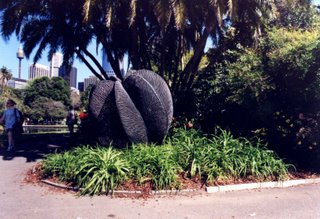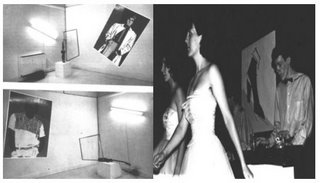
Nostalgic for art school life, I've been wondering now for some time what the art kids of today are up to. What's hip for art hipsters today? This very question was answered today by The Sun-Herald, a newspaper that often answers life's big questions. When I'm not sure what to eat, for instance, I look at the celebrity photo pages because without a doubt an image of what's trendy in finger food is positioned between party snaps of Antonia Kidman and Peter Morrissey. All the big names in Australian culture no less! When I need to invest intellectual shares in current affairs, I turn to Miranda Devine for an enlightened stance on all things right wing.
Today's art hipsters rarely appear in the Sunday press, unless of course Urban Style columnist Fernando Frisoni has snapped them during a day of cruising East Sydney for young hotties garbed in recycled clothing, designer accessories and lusty trout pouts. My anxieties that art school chic is not media worthy on Sundays were quickly extinguished by the Lifestyle section of the Sunday Life magazine supplement of The Sun-Herald. Filling four pages are fashion snaps of a young white girl/boy couple getting around town suitably disengaged and absorbed more in consumer cravings than each other. Titled "Art School," the subheading claims, "Pop-art punk delivers maximum impact: 15 minutes of fame guaranteed."
In the first image, reproduced here at The Artswipe, the boy chats on his mobile phone, his hair carefully simulating that skanky unwashed look popular with skaters and crackwhores. The fine print lists the designer items worn and the grand total for a budding male artist's Art School image is $1322. Let's hope he's the next Matthew Barney so he can pay off those mounting student loans. As for the girl, Art School cachet costs $2054 and a Starbucks latté. Maybe she'll be Björk to his Barney, so the whole episode in elegant-slumming with a HECS debt will be worth it in the long run.
And what do you think these kids make at art school? Well their thing is critiquing consumer culture, because that never dates. They heard Johnny Boy's song, "You Were the Generation that Bought More Shoes and You Get What You Deserve," and were so inspired they made a painting appropriating the song's title before going shopping because it's, like, a political act, man. What struck me about this art duo is how invested they are in a seething electroclash of binary oppositions. Pop Art meets Punk (well, according to the subheading at least). And Campbell Soup always works when it's followed with a Starbucks chaser.







